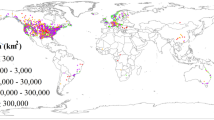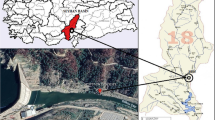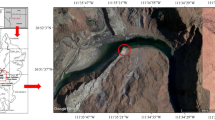Abstract
In recent years, the success of deep learning in many different fields of Engineering has attracted attention. Baseflow separation is one of the Engineering problems which remains difficult due to different hydro-climatic circumstances. In this study, we proposed a hybrid baseflow prediction model by combining analytical methods and deep learning algorithms. Six analytical methods were chosen and their performance was compared by different metrics. Baseflow-Lyne and Hollick algorithm (BFLOW-LHA) outperforms the others in terms of R2, Mean Absolute Error (MAE), BIAS, Nash–Sutcliffe Efficiency (NSE), and Root Mean Squared Error (RMSE) metrics. The proposed model was trained using streamflow and baseflow data generated by the BFLOW-LHA with the Dawa Melka Guba dataset and then tested on prediction for the basin's remaining three watersheds. The experimental results show that the proposed model improves the prediction of baseflow as compared with BFLOW-LHA and can be used for watersheds with similar characteristics.











Similar content being viewed by others
Data availability
All the relevant data are uploaded on GitHub and accessible via the following URL: https://github.com/wondiye8/baseflow
References
Aboelnour M, Gitau MW, Engel BA (2020) A comparison of streamflow and baseflow responses to land-use change and the variation in climate parameters using SWAT. Water 191(12):1–29
Chapman D (1999) Access Regulation Risk Management And Framework Design. Econ Press 18(4):68–79
Chapman T (1999) A comparison of algorithms for stream flow recession and baseflow separation. Hydrol Process 13(5):701–714
Duncan HP (2019) Baseflow separation—a practical approach. J Hydrol 575(5):308–313
Eckhardt K (2005) How to construct recursive digital filters for baseflow separation. Hydrol Process 19(2):507–515
Gregor M (2010) BFI+ 3.0 user’s manual. HydroOffice Software Package
Galli T, Chiclana F, Siewe F (2021) Quality properties of execution tracing, an empirical. Appl Syst Innov 20:35
Hochreiter S, Schmidhuber J (1997) Long short-term memory. Neural Comput 9:1735
Huyck AAO, Pauwels VRN, Verhoest NEC (2005) A base flow separation algorithm based on the linearized Boussinesq equation for complex hillslopes. Water Resour Res 41:W08415
Kouanda B, Coulibaly P, Niang D, Fowe T, Karambiri H, Paturel J-E (2018) Analysis of the performance of base flow separation methods using chemistry and statistics in Sudano–Sahelian watershed, Burkina Faso. Hydrol Curr Res 9(2):1–11
Ladson A, Brown RR, Neal B, Nathan R (2013) A standard approach to baseflow separation using the Lyne and Hollick filter. Aust J Water Resour 17:25–34
Lim SR, Schoenung JM (2010) Toxicity potentials from waste cellular phones, and a waste management policy integrating consumer, corporate, and government responsibilities. Waste Manage 30(8–9):1653–1660
Liu Z, Liu S, Ye J, Sheng F, You K, Xiong X, Lai G (2019) Application of a digital filter method to separate baseflow in the small watershed of Pengchongjian in Southern China. Forests 10(12):1065
Lott DA, Stewart MT (2016) Base flow separation: a comparison of analytical and mass balance methods. J Hydrol 535:525–533
Lu W, Li J, Li Y, Sun A, Wang J (2020) A CNN-LSTM-based model to forecast stock prices. Artif Intell Smart Syst Simul 2020:10
Lyne V, Hollick M (1979) Stochastic time-variable rainfall-runoff modelling. In: Institute of engineers Australia national conference. Institute of Engineers Australia, Barton, Vol 79, No 10, pp 89–93
Mazvimavi D, Meijerink AMJ, Stein A (2004) Prediction of base flows from basin characteristics: a case study from Zimbabwe/Prévision de débits de base à partir de caractéristiques du bassin: une étude de cas au Zimbabwe. Hydrol Sci J 49(4):715
Murphy DM, Solomon S, Portmann RW, Rosenlof KH, Forster PM, Wong T (2009) An observationally based energy balance for the Earth since 1950. J Geophs Res 114(17):16
Murphy S, Ouellon T, Ballard J-M, OuellonT CID (2011) Tritium–helium groundwater age used to constrain a groundwater flow model of a valley-fill aquifer contaminated with trichloroethylene (Quebec, Canada). Hydrogeol J 19(1):195–207
Murray G (2010) Framing globalization and work: a research agenda. J Indus Relat 52(1):1–25
Nandini GS, Kumar APS, Chidananda K (2021) Dropout technique for image classification based on extreme learning machine. Global Transit Proc 2(1):111–116
Nathan RJ, McMahon TA (1990) Evaluation of automated techniques for base flow and recession analyses. Water Resour Res 26(7):1465–1473
Pielke RA Sr, Adegoke J, BeltraáN-Przekurat A, Hiemstra CA, Lin J, Nair US, Niyogi D, Nobis TE (2007) An overview of regional land-use and land-cover impacts on rainfall. Tellus B: Chem Phys Meteorol 59(3):587–601
Rammal M, Archambeau P, Erpicum S, Orban P, Brouyère S, Pirotton M, Dewals B (2018) An operational implementation of recursive digital filter for base flow separation. Water Resour Res 54(10):8528–8540
Roy S, Mistri B (2013) Estimation of peak flood discharge for an ungauged river: a case study of the Kunur river, West Bengal. Geogr J 2013:11
Sivapalan M (2018) From engineering hydrology to Earth system science: milestones in the transformation of hydrologic science. Hydrol Earth Syst Sci 22(3):1665–1693
Sloto R, Crouse M (1996) HYSEP: a computer program for streamflow hydrograph separation and analysis. Water-Resources Investigations Report, US Geological Survey
Spongberg ME (2000) Spectral analysis of base flow separation with digital filters. Water Resour Res 36(3):745–752
Stadnyk TA, Asce M, Gibson JJ, Longstaffe FJ (2015) Basin-scale assessment of operational base flow separation methods. J Hydrol Eng 20(5):04014074
Stewart MT, Cimino J, Ross M (2007) Calibration of base flow separation methods with streamflow conductivity. Ground Water 45(1):17–27
Tallaksen LM (1995) A review of baseflow recession analysis. J Hydrol 165(1–4):349–370
Young AR, Gustard A, Bullock A, Sekulin AE, Croker KM (2000) A river network based hydrological model for predicting natural and influenced flow statistics at ungauged sites. Sci Total Environ 251–252(12):293–304
Acknowledgements
This study was performed by three academic staff at Jimma Institute of Technology, Jimma University, Ethiopia. The authors would like to thank the institute for its assistance with various resources, as well as MoWIE of Ethiopia for providing the dataset for our experiments. The authors would like to thank Jimma University for its support during the research work.
Funding
This study received no outside funding.
Author information
Authors and Affiliations
Corresponding author
Ethics declarations
Conflict of interest
The authors declare that they do not have any conflicts of interest about this work.
Additional information
Publisher's Note
Springer Nature remains neutral with regard to jurisdictional claims in published maps and institutional affiliations.
Rights and permissions
About this article
Cite this article
Abebe, W.T., Endalie, D. & Haile, G. Development of hybrid baseflow prediction model by integrating analytical method with deep learning. Sustain. Water Resour. Manag. 8, 97 (2022). https://doi.org/10.1007/s40899-022-00694-1
Received:
Accepted:
Published:
DOI: https://doi.org/10.1007/s40899-022-00694-1




